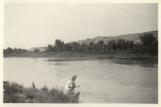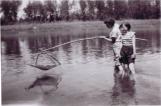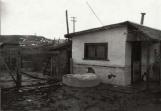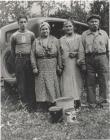2
As the weather warmed and the mine production slowed many families were forced to live on a tight budget. Although many miners would find supplementary work, at a farm or the like for the off-season, household budgets were stretched thin. The monetary stresses forced families to adopt the attitude of " Make do or do without".3
Florence Frances Yez watering her Sweet Peas1940's
East Coulee, Alberta
 Credits:
Credits:Dinosaur Valley Heritage Society
4
Families kept busy with summer activities such as gardening, canning, swimming, fishing, and picnics. Valley residents couldn't wait to break their gardens in the spring as they had much planting and sowing to do. As well as tending to their large gardens, families enjoyed foraging for berries and mushrooms.5
Florence Frances Yez trying her hand at fishing1940's
East Coulee, Alberta
 Credits:
Credits:Dinosaur Valley Heritage Society
6
Fishing was not a costly family activity, and almost always provided a fresh meal at the end of the day. Many enjoyed a catch like northern pike, goldeye, or trout.7
Sonja Parama (holding stick) and Marion Sereda fishing1949
 Credits:
Credits:Atlas Coal Mine Historical Society
8
Walter Crittall and Russell; two boys in old-fashioned swimming costumes with two dogs1928
 Credits:
Credits:Douglas Powell
9
All of these activities were not only social family gatherings, but a part of the "make do and do without" attitude that would get them through the off-season.The valley was a natural playground, and the families knew how to gain the most from their environment, enjoying it to the fullest. For example, a saskatoon picking expedition might include a quick stop at the swimming hole, and a break for "catch" or a ball game. These trips were not only a cultural endeavour but also enhanced a family's winter diet with preserves.
11
The "make do and do without" attitude comes up in every discussion or interview with miners and their families. For instance many remember when Christmas meant japanese oranges, and japanese oranges meant nice toilet paper."We loved it when Grama would iron each piece of green paper that came from around the Japanese oranges at Christmas time. These papers were so soft after they were ironed. She would hang them in the outhouse. During most of the year (I guess cause we wasted so much), it seemed that we were always out of toilet paper and ended up using newspaper or catalogue pages. We were very upset when Timothy Eaton put coloured pages in his catalogue (because it irritated your bottom!)"
12
Housing also tops the list when it comes to the "make do or do without" category. Company homes had wooden walls with canvas roofs and appeared more like tents than homes. As many as six men shared a tent as small as a chicken coop. Many company houses also shared one outhouse that was ill kept and a ses pool for disease.Miners were thrifty men, scouring the valley for any material suitable for building a home. Often these materials would be close at hand...maybe too close. Boxcar doors that could be "borrowed" from the mine sites under the cover of darkness were often used to make houses. The "borrowed" materials were used to slap together a home in as little as a day. Many of these homes had no running water or electricity, and the bathroom or outhouse was "out back". Other popular methods of construction were willow and mud, or straw and manure. A few of these miners shack still remain standing. Many have been added onto over the years, but still have the boxcar door skeleton that dates the house back to it's beginnings as a miners shack.
13
The Szabo family's home after a flood, with ice resting against it1948?
Rosedale, Alberta
 Credits:
Credits:The Szabo Family

